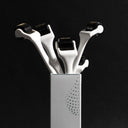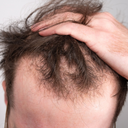When it comes to hair loss treatments, you might have come across both Propecia and finasteride. But what's the difference between the two?
In this article, we'll break down the key differences, pros, and cons, so you can make an informed decision in the "Propecia vs finasteride" debate and choose the best option for your hair loss journey.
Table of content
Propecia vs Finasteride: Key differences
Propecia is the brand name for a medication produced by Merck & Co., containing the active ingredient finasteride. Finasteride is also available as a generic version under its own name. Essentially, Propecia and finasteride are the same drug, but Propecia is the branded version, while finasteride is the generic.
As your leading source for hair health information over the past 4 years, we never compromise on accuracy. When it comes to your health, you deserve information you can truly rely on - and earning your trust is our top priority.
Here's how Scandinavian Biolabs ensures every piece of content meets the highest standards of accuracy and integrity:
- Credentialed Experts: Our reviewers are actively practicing doctors and medical researchers
- Stringent Reviews: Content undergoes rigorous editing by subject specialists and review by a practicing doctor.
- Evidence-Based: We rely on well-established research from trusted scientific sources like peer-reviewed journals and health authorities.
- Full Transparency: Our editorial standards, writer credentials, reviewer credentials, correction process, and funding are all publicly documented.
- Independent Voice: While we do promote products, we operate in a vacuum to business operations. Our main goal is just an unwavering commitment to providing medically-sound guidance.
You can count on Scandinavian Biolabs to consistently deliver the trustworthy health information you deserve. Read our Editorial Standards.
Propecia vs Finasteride: Which is more effective?

Propecia and finasteride are equally effective in treating male pattern baldness, as both contain the same active ingredient and work by inhibiting DHT formation.
Despite being marketed under different names, Propecia and finasteride offer the same results in combating androgenetic alopecia, commonly known as male pattern baldness.
Both medications share the same active ingredient, finasteride, and work by blocking the formation of DHT, the hormone responsible for hair loss.
Dermatologists often prescribe these treatments, with numerous studies supporting their effectiveness. For instance, a study involving 3177 Japanese men showed significant hair regrowth after 3.5 years of daily finasteride use.
The research also indicated that prolonged treatment leads to better results, with minimal side effects reported. This solidifies the position of both Propecia and finasteride as reliable options for long-term hair loss management.
Propecia vs Finasteride: Which has more side effects?

Propecia and finasteride are the same hair loss treatment, just with different names.
Similar to the benefits of the two versions, both Propecia and Finasteride cause the same side effects. Consequently, the risk of developing these side effects is quite low.
Since this drug has a steroid base, many people spread some rumors about how it causes sexual dysfunction (e.g., erectile dysfunction, premature ejaculation, decreased libido). While these side effects are possible, their occurrence has been relatively low in clinical reports.
According to a press release from the Food and Drug Administration (FDA), their agents received 421 reports of sexual dysfunction in 13 years. The vast majority of these cases improved after the discontinuation of the drug.
Compared to the overall number of patients who take this drug, the percentage of reported side effects has been relatively low.
Propecia vs Finasteride: Which one is better?

After covering the benefits, effectiveness, and side effects of Propecia Vs. Finasteride, it is clear that both versions of the drug offer identical responses.
Both Propecia and finasteride work by preventing the conversion of testosterone to DHT. This stops the shrinking of hair follicles and reverses balding.
However, there is one aspect that makes Propecia vs. Finasteride very different – COST.
Typically, the cost of Propecia is around $75-$80 a month. Additionally, most insurance plans do not cover this drug.
On the other end, Finasteride is much cheaper and could be covered by insurance as a Tier 1 medication. Consequently, you may get this drug for as little as a $10-$20 copay.
You might be asking: “You said it’s the same drug, so why is Propecia more expensive?”
The reason for this price disparity boils down to the cost of production. You see, when a company receives a patent for a drug, they possess exclusive rights to produce and sell the drug for a limited period of time (12 years on average).
Once the patent ends, other companies can start producing the generic version.
Therefore, Generic Finasteride is cheap because the company that produces it has the necessary data on the drug’s development and effectiveness (provided by the brand-name company), which cuts costs significantly.
Are there alternatives to Propecia and finasteride?
You might think to yourself, what can I do to avoid these side effects.
Worry not, as we developed a quick guide on the best alternatives you can take.
What is Propecia?

Propecia is a prescription drug used to treat androgenic alopecia (i.e., male pattern baldness) and prostate disorders (e.g., benign prostatic hyperplasia).
Propecia is approved by the MHRA for treating hair loss.
The ‘steride’ part in Finasteride describes the steroid nature of this drug. On the other hand, the term Propecia originates from combining the words Pro and alopecia, which is a common theme that you will see in branded drugs.
This drug belongs to a class of medication known as 5-Alpha-Reductase Inhibitors. [2]
What are the side effects of Propecia?
- Pain in the breast area
- Nipple discharge
- Changes in the structure of the breasts
- Decreased libido
- Sexual dysfunction

Propecia is available in tablet form. The primary function of this drug is to inhibit the transformation of testosterone into 5α-dihydrotestosterone (DHT). Note that the elevated concentration of DHT is the hallmark of androgenetic alopecia. [3]
What ingredients are in Propecia?
- Finasteride
- Lactose monohydrate
- Hydroxypropyl methylcellulose
- Hydroxypropyl cellulose
- Microcrystalline cellulose
- Pregelatinized starch
- Sodium starch glycolate
- Titanium dioxide
- Magnesium stearate
- Talc
- Docusate sodium
- Yellow ferric oxide
- Red ferric oxide
We call these substances inactive ingredients, which serve various purposes, including the conservation of the drug and increasing its bioavailability. [4]
Propecia is primarily used to treat hair loss, whereas another version of the drug – Proscar – addresses benign prostate hyperplasia.
Note that physicians do not prescribe this drug for women or children. [1]
What is Finasteride?

Finasteride is an FDA-approved pharmacologic agent that treats benign prostate hyperplasia and androgenic alopecia. The drug received FDA approval in 1992 for BPH. Six years after, the FDA approved it to treat male pattern baldness.
Finasteride may also be called generic Propecia when it is sold under the brand name.
Note that the dosage used to treat BPH and androgenetic alopecia are different.
- Benign prostatic hyperplasia – 5 milligrams a day [5]
- Androgenetic alopecia – 1 milligram a day [6]
What are the side effects of Finasteride?
- Decreased sex drive
- Erectile dysfunction
- Ejaculation disorder
- Increase in breast size and tenderness
- Skin rash
Generally, these side effects have been reported as mild and may resolve in a few days or weeks. Your doctor might decide to stop prescribing this drug based on a benefit-risk analysis.
What can you experience if you're allergic to Finasteride?

- Edema (i.e., swelling) of the lips, tongue, throat, or face
- Urticaria (i.e., extended rash all over the body)
- Generalized pruritus (i.e., severe itchiness)
- Dyspnea (i.e., difficulty breathing)
Like all medications on the market, Finasteride may trigger an allergic reaction that requires immediate medical attention. For most people, this reaction occurs after the first or second time taking the drug. [7]
We should note that this reaction is exceptionally uncommon.
Conclusion
It is now well known that Finasteride and Propecia are both effective for hair loss treatments.
Finasteride is the generic active ingredient that is used in several branded drugs such as Propecia.
Since it is also possible to buy finasteride as a generic drug and not in a branded formulation, here are the differences in price are understandable.
There are no differences in terms of efficacy or side effects because the active ingredient we are discussing is always finasteride.
The only difference is the price and ingredients.
Hopefully, this article helped you understand the difference between Propecia and Finasteride.
FAQs
Can I switch from Propecia to finasteride?
Yes, you can switch from Propecia to finasteride as they contain the same active ingredient and are essentially the same drug. The primary difference between them is the price, with Propecia being a branded version. Both are effective in treating male pattern hair loss.
Which form of finasteride is best?
While both oral and topical forms of finasteride are effective, many men find that topical finasteride is less likely to cause the unpleasant side effects sometimes associated with oral finasteride tablets. Therefore, topical finasteride might be considered the better option for those concerned about side effects.





